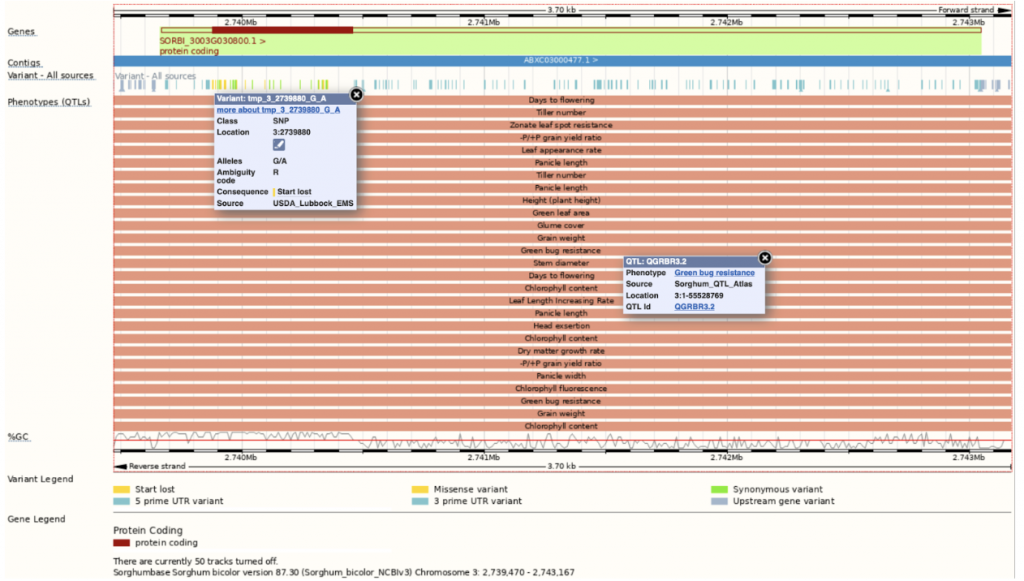The sugarcane aphid (SCA; Melanaphis sacchari) detrimentally impacts sorghum yield. It is possible to use pesticides to manage this pest, but they do not work well when there is a drastic growth in the infestation. In addition, the sticky honeydew waste produced by these aphids affects harvesting, thus reducing yield. Selecting for host plant resistance (HPR) is not only more effective, but also more environmentally friendly. In order to optimize this strategy, an understanding of the timing of the pest in relation to the developmental stage of the plant is critical. The effect of cuticular waxes and sugar levels at different development stages on SCA has not been investigated. To explore this, scientists from the University of Nebraska-Lincoln, the USDA-ARS, and the University of Minnesota Duluth used Electrical Penetration Graph (EPG) technique to monitor the feeding behavior of SCA on two- and six-week-old BTx623 sorghum plants. The results indicated that SCA spent less time in the pathway phase, in which they are searching for the nutrient source, in the six-week old sorghum plants, as well as fed for a longer period on the phloem sap and spent longer in the passive ingestion phase, in which nutrients are consumed. The researchers postulate that it was easier for the aphids to locate the phloem in the larger plants. Differences in wax and sugar content were analyzed for how this may affect SCA infestation. Analysis of cuticular wax in the present study revealed that α-amyrin and isoarborinone increased in the six-week-old plants, but not in the two-week old ones, indicating that SCA fecundity on six-week-old plants may be due to an increase in these triterpenoid derivatives. In both the two- and six-week-old plants trehalose, which is toxic to SCA, increased in response to the SCA feeding. However, it was only in the two-week-old plants that the SCA infestation resulted in decreased sucrose and increased glucose and fructose content; these sugars impact aphid growth and plant response. Although, the results of the 8-hour EPG analysis indicated that the aphids preferred the six-week old sorghum plants, the greater amount of aphid colonization in the two-week-old plants at 10 days may be due to consumption of metabolites, like the triterpenoids, in the six-week old sorghum plants. The extended time tapped into the phloem may have helped to increase that consumption. The study by Cardona et al showed that sorghum plant age greatly influences the colonization of SCA through differences in triterpenoids and available sugars.
In this study, we monitored sugarcane aphid preferences for juvenile versus adult sorghum plants and also monitored aphid feeding behavior on these plants. Our results indicated that SCA preferred the adult plants as a source of food, but grew more rapidly on the juvenile plants. Juvenile plants contained more sucrose, which may account for these findings. – Scott Sattler
Overall, our findings underscore a complex interaction between the aphids and the plants, and manipulating the leaf cuticular waxes and the sugars may represent new ways to strengthen sorghum resistance to this economically injurious pest. Additionally, novel ways to control the insect pests may reduce our dependence on toxic and harmful pesticides so we have a much cleaner and safer environment. – Joe Louis
SorghumBase Examples:
A

B

Reference:
Cardona JB, Grover S, Bowman MJ, Busta L, Kundu P, Koch KG, Sarath G, Sattler SE, Louis J. Sugars and cuticular waxes impact sugarcane aphid (Melanaphis sacchari) colonization on different developmental stages of sorghum. Plant Sci. 2023 Feb 18;330:111646. PMID: 36806611. DOI: 10.1016/j.plantsci.2023.111646. Read more
Related Project Website:
Louis Lab at the University of Nebraska-Lincoln: https://plant-insect-interactions-lab.unl.edu/

